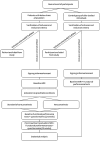Human-Prosthetic Interaction (HumanIT): A study protocol for a clinical trial evaluating brain neuroplasticity and functional performance after lower limb loss
- PMID: 38512879
- PMCID: PMC10956762
- DOI: 10.1371/journal.pone.0299869
Human-Prosthetic Interaction (HumanIT): A study protocol for a clinical trial evaluating brain neuroplasticity and functional performance after lower limb loss
Erratum in
-
Correction: Human-Prosthetic Interaction (HumanIT): A study protocol for a clinical trial evaluating brain neuroplasticity and functional performance after lower limb loss.PLoS One. 2025 Jan 24;20(1):e0318371. doi: 10.1371/journal.pone.0318371. eCollection 2025. PLoS One. 2025. PMID: 39854397 Free PMC article.
Abstract
Background: Lower limb amputation contributes to structural and functional brain alterations, adversely affecting gait, balance, and overall quality of life. Therefore, selecting an appropriate prosthetic ankle is critical in enhancing the well-being of these individuals. Despite the availability of various prostheses, their impact on brain neuroplasticity remains poorly understood.
Objectives: The primary objective is to examine differences in the degree of brain neuroplasticity using magnetic resonance imaging (MRI) between individuals wearing a new passive ankle prosthesis with an articulated ankle joint and a standard passive prosthesis, and to examine changes in brain neuroplasticity within these two prosthetic groups. The second objective is to investigate the influence of prosthetic type on walking performance and quality of life. The final objective is to determine whether the type of prosthesis induces differences in the walking movement pattern.
Methods: Participants with a unilateral transtibial amputation will follow a 24-week protocol. Prior to rehabilitation, baseline MRI scans will be performed, followed by allocation to the intervention arms and commencement of rehabilitation. After 12 weeks, baseline functional performance tests and a quality of life questionnaire will be administered. At the end of the 24-week period, participants will undergo the same MRI scans, functional performance tests and questionnaire to evaluate any changes. A control group of able-bodied individuals will be included for comparative analysis.
Conclusion: This study aims to unravel the differences in brain neuroplasticity and prosthesis type in patients with a unilateral transtibial amputation and provide insights into the therapeutic benefits of prosthetic devices. The findings could validate the therapeutic benefits of more advanced lower limb prostheses, potentially leading to a societal impact ultimately improving the quality of life for individuals with lower limb amputation.
Trial registration: NCT05818410 (Clinicaltrials.gov).
Copyright: © 2024 Lathouwers et al. This is an open access article distributed under the terms of the Creative Commons Attribution License, which permits unrestricted use, distribution, and reproduction in any medium, provided the original author and source are credited.
Conflict of interest statement
The authors have declared that no competing interests exist.
Figures
References
Publication types
MeSH terms
Associated data
LinkOut - more resources
Full Text Sources
Medical



